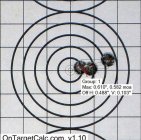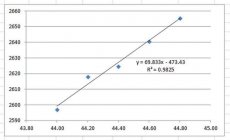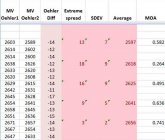You are using an out of date browser. It may not display this or other websites correctly.
You should upgrade or use an alternative browser.
You should upgrade or use an alternative browser.
Long range load development at 100 yards.
- Thread starter Erik Cortina
- Start date
Erik Cortina
Team Lapua Brux Borden Captain
savageshooter86 said:
What kind of chronograph? 43.4 seems unusually high compared to the loads on each side of it.
Oehler 35P w/ 4' rail
I thought that was odd too
43.1-- 2675,2669,2677,2663
43.4-- 2713,2673,2685,2674
43.7-- 2717,2702,2717
44.0-- 2735,2744,2743
I thought that was odd too
43.1-- 2675,2669,2677,2663
43.4-- 2713,2673,2685,2674
43.7-- 2717,2702,2717
44.0-- 2735,2744,2743
Erik Cortina
Team Lapua Brux Borden Captain
savageshooter86 said:Oehler 35P w/ 4' rail
I thought that was odd too
43.1-- 2675,2669,2677,2663
43.4-- 2713,2673,2685,2674
43.7-- 2717,2702,2717
44.0-- 2735,2744,2743
I would run test again with 5 shot groups. Are you sure you didn't mix a 43.7 load with the 43.4?
I used to do the seating depth at 300 yards, but now I do it all at 100 yards since I have found that if it shoots well at 100, it will shoot at 300.
Virgil King (of the Houston Warehouse notoriety) found the same thing back in the 70's & 80's.
Excellent reading for anyone who hasn't had the pleasure.
http://precisionrifle.files.wordpress.com/2013/10/secrets-of-the-houston-warehouse-by-dave-scott-precision-shooting-magazine-special-edition-1-1993.pdf
Stork
Virgil King (of the Houston Warehouse notoriety) found the same thing back in the 70's & 80's.
Excellent reading for anyone who hasn't had the pleasure.
http://precisionrifle.files.wordpress.com/2013/10/secrets-of-the-houston-warehouse-by-dave-scott-precision-shooting-magazine-special-edition-1-1993.pdf
Stork
AlanPF
Victoria Australia
I have a question, and sincerely hope that hasn't already been answered on the 88 pages  of this topic.
of this topic.
If you use this method at 100 yards to tune loads for 1000, surely you would need to also test at 1000 to confirm? Because there are some sources of long range inaccuracy that will not be detectable at 100 yards. One is bullet uniformity, or more particularly BC consistency. BCs can vary by several %. Bryan Litz quoted a figure of 8% improvement in BC with a Whidden pointing die. Let's say two projectiles vary by 4% in BC, with one having a G7 BC of 0.300 and the other 0.312, and identical muzzle velocities of 3000 fps. I calculate the difference in bullet drop at 100 yards to be 0.003" which is undetectable, but at 1000 yards the difference is nearly 6 inches, enough to put you out of the 10 ring.
If you use this method at 100 yards to tune loads for 1000, surely you would need to also test at 1000 to confirm? Because there are some sources of long range inaccuracy that will not be detectable at 100 yards. One is bullet uniformity, or more particularly BC consistency. BCs can vary by several %. Bryan Litz quoted a figure of 8% improvement in BC with a Whidden pointing die. Let's say two projectiles vary by 4% in BC, with one having a G7 BC of 0.300 and the other 0.312, and identical muzzle velocities of 3000 fps. I calculate the difference in bullet drop at 100 yards to be 0.003" which is undetectable, but at 1000 yards the difference is nearly 6 inches, enough to put you out of the 10 ring.
Erik Cortina
Team Lapua Brux Borden Captain
AlanPF said:I have a question, and sincerely hope that hasn't already been answered on the 88 pagesof this topic.
If you use this method at 100 yards to tune loads for 1000, surely you would need to also test at 1000 to confirm? Because there are some sources of long range inaccuracy that will not be detectable at 100 yards. One is bullet uniformity, or more particularly BC consistency. BCs can vary by several %. Bryan Litz quoted a figure of 8% improvement in BC with a Whidden pointing die. Let's say two projectiles vary by 4% in BC, with one having a G7 BC of 0.300 and the other 0.312, and identical muzzle velocities of 3000 fps. I calculate the difference in bullet drop at 100 yards to be 0.003" which is undetectable, but at 1000 yards the difference is nearly 6 inches, enough to put you out of the 10 ring.
Bullet BC uniforming is something that needs to be handled separately. You can not tune a gun to compensate for bad bullets. Get your gun properly tuned at 100 yards and get your bullets sorted to minimize BC differences and it will shoot at 1,000 yards.
Erik Cortina said:You can not tune a gun to compensate for bad bullets. Get your gun properly tuned at 100 yards and get your bullets sorted to minimize BC differences and it will shoot at 1,000 yards.
Good answer that. Sorting then maybe tweaking bullets pays off only after you've worked out the other parameters that affect accuracy AND consistency out where you can see the results on paper.
Did an OCW with my 24†AI AT 308 today and here are the results: Berger 185 Juggernaut, Varget, Lapua brass, Tula LRP. Bullets seated to 0.010†jump. Conditions: 46 degree, 80 humidity, pressure at 29.23. Powder range 44.0 to 44.8 grains at 0.2 grain interval – no pressure signs. QL predicted OCW at 44.5 grains.
Top right 3 rounds fouler done with cheap Win brass/175 SMK/42 grain Varget so ignore.
Plotted average POI using OT data with red dots and arrows showing movement. Looks like average POI for the 5 groups did not change much within powder range tested. Probably the most movement outside group was the first charge i.e. 44.0 grains.
MV captured with Ohler 36p. Average MV linear within powder range. All groups had single digit SDEV.
First question is what’s next? Since the average POI did not move much and group size was small, should I still try to optimize with seating depth adjustment?
Top right 3 rounds fouler done with cheap Win brass/175 SMK/42 grain Varget so ignore.
Plotted average POI using OT data with red dots and arrows showing movement. Looks like average POI for the 5 groups did not change much within powder range tested. Probably the most movement outside group was the first charge i.e. 44.0 grains.
MV captured with Ohler 36p. Average MV linear within powder range. All groups had single digit SDEV.
First question is what’s next? Since the average POI did not move much and group size was small, should I still try to optimize with seating depth adjustment?
Attachments
I have a question about load testing at 100 yards when trying to keep everything in mag length. When seated to 2.800 I am jumping the bullet .140 in my 308. I can tell I'm in a node but the seating depth is not best. Would you still back off 2.800 in .003 increments or use something like .010 increments since you are sooooo far off the lands to start??
Brians356
Silver $$ Contributor
jsthntn247 said:I have a question about load testing at 100 yards when trying to keep everything in mag length. When seated to 2.800 I am jumping the bullet .140 in my 308. I can tell I'm in a node but the seating depth is not best. Would you still back off 2.800 in .003 increments or use something like .010 increments since you are sooooo far off the lands to start??
Keep in mind the seating depth change affects not just bullet jump, but also net case capacity. So don't abandon small increments just because the bullet jump is so large to start with.
Erik Cortina
Team Lapua Brux Borden Captain
jsthntn247 said:I have a question about load testing at 100 yards when trying to keep everything in mag length. When seated to 2.800 I am jumping the bullet .140 in my 308. I can tell I'm in a node but the seating depth is not best. Would you still back off 2.800 in .003 increments or use something like .010 increments since you are sooooo far off the lands to start??
Do .003" at a time. You will find a node.
Wow! 61 views and not one feedback.. Must be really bad or really good! ;Djlow said:Did an OCW with my 24†AI AT 308 today and here are the results: Berger 185 Juggernaut, Varget, Lapua brass, Tula LRP. Bullets seated to 0.010†jump. Conditions: 46 degree, 80 humidity, pressure at 29.23. Powder range 44.0 to 44.8 grains at 0.2 grain interval – no pressure signs. QL predicted OCW at 44.5 grains.
Top right 3 rounds fouler done with cheap Win brass/175 SMK/42 grain Varget so ignore.
Plotted average POI using OT data with red dots and arrows showing movement. Looks like average POI for the 5 groups did not change much within powder range tested. Probably the most movement outside group was the first charge i.e. 44.0 grains.
MV captured with Ohler 36p. Average MV linear within powder range. All groups had single digit SDEV.
First question is what’s next? Since the average POI did not move much and group size was small, should I still try to optimize with seating depth adjustment?
Brians356
Silver $$ Contributor
jlow said:Wow! 61 views and not one feedback.. Must be really bad or really good! ;Djlow said:Did an OCW with my 24†AI AT 308 today
I think we're all waiting for Erik to comment - I know I am. It's his thread, and his methodology.
(Not sure why you refer to "OCW" however, that's a quite different methodology than what's happening here.)
Erik Cortina
Team Lapua Brux Borden Captain
brians356 said:jlow said:Wow! 61 views and not one feedback.. Must be really bad or really good! ;Djlow said:Did an OCW with my 24†AI AT 308 today
I think we're all waiting for Erik to comment - I know I am. It's his thread, and his methodology.
(Not sure why you refer to "OCW" however, that's a quite different methodology than what's happening here.)
Actually, that's part if the reason I did not comment on it, I thought he was doing something different and simply posting results for comparison.
I'll take a look and give you my feedback.
Erik Cortina
Team Lapua Brux Borden Captain
jlow said:Did an OCW with my 24†AI AT 308 today and here are the results: Berger 185 Juggernaut, Varget, Lapua brass, Tula LRP. Bullets seated to 0.010†jump. Conditions: 46 degree, 80 humidity, pressure at 29.23. Powder range 44.0 to 44.8 grains at 0.2 grain interval – no pressure signs. QL predicted OCW at 44.5 grains.
Top right 3 rounds fouler done with cheap Win brass/175 SMK/42 grain Varget so ignore.
Plotted average POI using OT data with red dots and arrows showing movement. Looks like average POI for the 5 groups did not change much within powder range tested. Probably the most movement outside group was the first charge i.e. 44.0 grains.
MV captured with Ohler 36p. Average MV linear within powder range. All groups had single digit SDEV.
First question is what’s next? Since the average POI did not move much and group size was small, should I still try to optimize with seating depth adjustment?
I would go with 44.2
Similar threads
- Replies
- 61
- Views
- 14,530
Upgrades & Donations
This Forum's expenses are primarily paid by member contributions. You can upgrade your Forum membership in seconds. Gold and Silver members get unlimited FREE classifieds for one year. Gold members can upload custom avatars.

Click Upgrade Membership Button ABOVE to get Gold or Silver Status.
You can also donate any amount, large or small, with the button below. Include your Forum Name in the PayPal Notes field.
To DONATE by CHECK, or make a recurring donation, CLICK HERE to learn how.

Click Upgrade Membership Button ABOVE to get Gold or Silver Status.
You can also donate any amount, large or small, with the button below. Include your Forum Name in the PayPal Notes field.
To DONATE by CHECK, or make a recurring donation, CLICK HERE to learn how.















